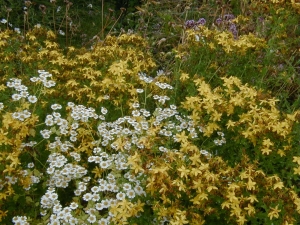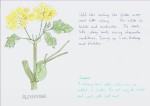Tansy (Tanacetum vulgare)
 This plant will be considered little better than a weed by many modern gardeners because it spreads so easily and can become invasive. However, to our ancestors it was an extremely useful addition to the garden – and not just for its flowers. The fresh green leaves of tansy are some of the first to appear in the early spring, and added to pottage were considered a ‘spring tonic’ potherb – a valuable source of vitamin C after months on a diet of mainly preserved and dried food. The plant even gives its name to a particular springtime recipe – a tansy was similar to an omelette, but the beaten eggs were thickened with flour and then flavoured with enough ground tansy that it coloured the mixture green. Sometimes other herbs were substituted but the dish was still called a tansy. DO NOT TRY THIS AT HOME – tansy is an extremely bitter plant and we only use it in our cooking in very small amounts when the leaves are very young. In large doses it had a medicinal use – as a purge, so be warned! When it flowers in the summer tansy produces masses of small yellow flowers which make a lovely yellow dye used for the clothing and textiles of the time. And finally, as the leaves become increasingly large, old and bitter, bunches were picked to hang at doorways and windows, and placed under mattresses to keep vermin and bugs away.
This plant will be considered little better than a weed by many modern gardeners because it spreads so easily and can become invasive. However, to our ancestors it was an extremely useful addition to the garden – and not just for its flowers. The fresh green leaves of tansy are some of the first to appear in the early spring, and added to pottage were considered a ‘spring tonic’ potherb – a valuable source of vitamin C after months on a diet of mainly preserved and dried food. The plant even gives its name to a particular springtime recipe – a tansy was similar to an omelette, but the beaten eggs were thickened with flour and then flavoured with enough ground tansy that it coloured the mixture green. Sometimes other herbs were substituted but the dish was still called a tansy. DO NOT TRY THIS AT HOME – tansy is an extremely bitter plant and we only use it in our cooking in very small amounts when the leaves are very young. In large doses it had a medicinal use – as a purge, so be warned! When it flowers in the summer tansy produces masses of small yellow flowers which make a lovely yellow dye used for the clothing and textiles of the time. And finally, as the leaves become increasingly large, old and bitter, bunches were picked to hang at doorways and windows, and placed under mattresses to keep vermin and bugs away.
Apothecary rose (Rosa gallica)
This is one of the earliest cultivated species of rose, probably introduced to this country by the Romans. Of course, it looks and smells beautiful, but there is much more to it than that. When in flower, the blooms need to be picked on a daily basis. But always remember to remove the white ’heel’ of the rose petal – it is bitter. The simplest culinary use would be to sprinkle petals over a ‘salat’ – a lovely touch easy to replicate today. We also use the chopped petals to flavour our hand churned butter during dairying demonstrations. Rose honey would be a special sweet treat (sugar was far too expensive at this point in time for ordinary people to make jams and jellies). Medicinally, the petals were used with honey to make a gentle medicine for childrens coughs and sore throats. Rosewater and rose vinegar would be made for the store cupboard. And the petals were used to make rosary beads.
Elderflowers (Sambucus nigra)
I wanted to make the point that not all the flowers used by our Tudor ancestors would be purpose grown in a garden plot. For the majority of the population, living in, or within easy reach, of the countryside the rural environment would also be seen as a source of food and medicine. Elderflowers are a case in point. In late spring the flower heads would be picked and dipped in batter and then deep fried – tempura is nothing new! Crushed in a bowl of water the flowers made a moisturising wash for hands and face. And made into a herbal vinegar or infusion were a treatment for dry throats and coughs. But be careful to leave enough – the berries will be equally useful in the autumn.
St John’s Wort (Hypericum perforatum)
 A yellow flowered plant, allegedly introduced to this country by the Romans. Invasive, it is likely to colonise any spare ground in Bayleaf garden if left to its own devices. The plant gets its common name from the belief that the flowers were best harvested on St John’s Day, June 24th. And the reason for harvesting the flowers? They were used medicinally, both internally and externally. Internally, the plant was used to treat depression, by being made into a herbal infusion or, ideally if you could afford it, by steeping in wine – NEVER take internally today unless medically supervised. Externally, St John’s Wort was used to make an oil or ointment to be applied to problem skin – the flowers leach a dramatic red colouring into the oil. The leaves and flowers also make a natural dye, producing shades of yellow, yellowy green and pink, depending on the mordant used. It is supposed to be possible to get a true red, but I have never been able to achieve this – please let me know the secret if you have.
A yellow flowered plant, allegedly introduced to this country by the Romans. Invasive, it is likely to colonise any spare ground in Bayleaf garden if left to its own devices. The plant gets its common name from the belief that the flowers were best harvested on St John’s Day, June 24th. And the reason for harvesting the flowers? They were used medicinally, both internally and externally. Internally, the plant was used to treat depression, by being made into a herbal infusion or, ideally if you could afford it, by steeping in wine – NEVER take internally today unless medically supervised. Externally, St John’s Wort was used to make an oil or ointment to be applied to problem skin – the flowers leach a dramatic red colouring into the oil. The leaves and flowers also make a natural dye, producing shades of yellow, yellowy green and pink, depending on the mordant used. It is supposed to be possible to get a true red, but I have never been able to achieve this – please let me know the secret if you have.
Alexanders (Smyrnium olusatrum)
 A Roman introduction but, easy to grow as it self-seeds freely, quickly become common. A very useful plant because all parts of it were used in their season, including the flowers. It tastes similar to a mild celery. The leaves come through early in the spring to make a welcome fresh potherb. Then the flower heads can be picked, dipped in batter and deep fried, or pickled for use in salads. As the plant grows the stems become thick and hollow and can be chopped and used in cooking. Later, the seeds can be collected and used as a seasoning, similarly to celery seed. Medicinally it was used in the past as a diuretic.
A Roman introduction but, easy to grow as it self-seeds freely, quickly become common. A very useful plant because all parts of it were used in their season, including the flowers. It tastes similar to a mild celery. The leaves come through early in the spring to make a welcome fresh potherb. Then the flower heads can be picked, dipped in batter and deep fried, or pickled for use in salads. As the plant grows the stems become thick and hollow and can be chopped and used in cooking. Later, the seeds can be collected and used as a seasoning, similarly to celery seed. Medicinally it was used in the past as a diuretic.
Cowslips (Primula veris)
A native plant, its name comes from the Old English cūslyppe meaning cow dung, probably because the plant was often found growing amongst the manure in cow pastures! The flowers were used to flavour vinegar and in salads. Medicinally, the flowers were believed to make an excellent ointment to treat wrinkles.
Lavender (Lavandula officinalis)
A Roman introduction to this country, its name derives from the Latin verb ‘lavare’ to wash, showing where it was frequently used to perfume both body, clothing, bedding and house. Lavender was more commonly used in cooking in the past than it is today, when it is considered to be an ‘acquired’ taste. We use the flowers to flavour butter, batters and sauces just as the Tudors did. And it was also a medicinal plant, making an ointment which was slightly antiseptic and good for applying to minor burns, cuts and grazes. The smell of lavender was also believed to relieve headaches and induce sleep.
Mullein (Verbascum thapsus)
You may be surprised to see this plant listed here but it has a long history of use as an herbal remedy. The flowers were macerated in oil to make a common treatment for ear aches and infections. The oil was also thought to be good for skin problems such as severe rashes and eczema.
